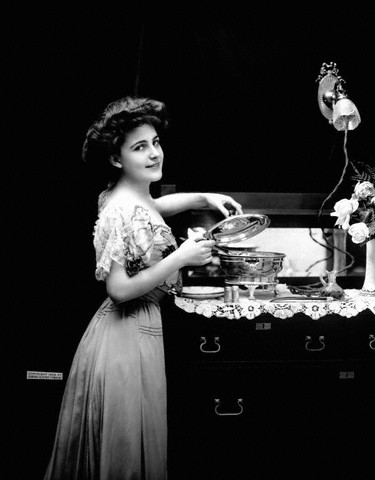
The chafing dish (from the Old French chauffer, “to make warm”) gained a certain cache in the Gilded Age, morphing from a simple brazier in which to gently cook dishes away from fire, to a luxury item made of copper and silver. Its roots were in the 16th century, as early cookbooks recognized the delicacy of such items as eggs, cream, and fish, and it was used to keep food warm before serving.
By the 1890s, the chafing dish became indispensable to hostesses, and it became synonymous with elegant entertaining at luncheon, tea, and supper.
Moreover, with the rise of the “servant problem”—that dreaded issue plaguing upper and middle-class women, who were unable to keep help—it behooved housewives to learn to cook, and with the chafing dish deemed fashionable by social arbiters, Mrs. Knickerbocker or Mrs. Boston Brahmin eagerly rolled up her sleeves and set to empress her friends with her culinary talents.
The chafing dish also found favor with bachelors and bachelor girls. The latter of limited time, and the former of limited experience, the chafing dish made fixing meals economical, quick, and simple. In tandem with this use was the midnight supper, where a bachelor or bachelor girl played host or hostess in their apartment, and entertained their co-ed group of friends with a meal cooked in the device.
To meet the insatiable demand for chafing dishes, dozens of cookbooks published especially for the chafing dish were released, and existing cookbooks were hastily updated to include sections on using the chafing dish. The cookbooks not only inspired new meals with their emphasis on dainty treats, but new eating patterns, with the average American adding teas, luncheons, and suppers to their mealtime schedule.
Today, chafing dishes are quite expensive, since they are mostly used in catering, but I have seen some in the $50-100 range. If you manage to track one down (though I think a small skillet on low heat can be substituted), here are a few dainty recipes from popular Gilded Age cooks:
Fannie Merritt Farmer’s Chafing Dish Possibilities (1898)
DEVILED CRABS
Melt two tablespoons (tbs) of butter, add two tbs of flour, and pour on gradually 1 1/4 cups of chicken stock. As soon as mixture thickens, add one cup crab meat, one-fourth cup finely chopped mushrooms, one-half teaspoon (tsp) salt; one-fourth tsp of paprika, two tbs of sherry, the yolks of two eggs, and one tsp of finely chopped parsley. Cook. Serve with saltine crackers.
SAUTED BANANAS
Remove skins from three bananas, cut in halves lengthwise, and cut again in halves crosswise. Put one tbs butter in blazer; when hot add bananas and cook until soft, turning once. Drain, sprinkle with powdered sugar, and a few drops of lemon juice; orange juice or sherry may be used if preferred.
Alice J. James’s The Chafing Dish (1912)
SHERRY OMELETTE WITH WHIPPED CREAM
Beat four eggs with four dessertspoonfuls of sherry, turn into the blazer in which is a tbs of hot butter. When ready to fold, sprinkle on two pinches of salt and when folded, dredge generously with powdered sugar. Serve with a ladleful of whipped cream on each portion, sweetened to taste.
H. L. Sawtelle’s What One Can Do with a Chafing-Dish (1890)
CURRY OF COLD ROAST BEEF
Cut some slices of cold roast beef into rather small, square pieces, and dredge them with flour. Chop a small onion fine, and fry it in two tbs of butter in the chafing-dish; add a gill (1/2 pint or 1/2 cup) of stock, and one tbs of curry powder. Put in the pieces of beef, and let all simmer ten or fifteen minutes.
BEIGNETS DE POMMES
Take some soft, tart apples, peel and remove the pips; cut in round, thin slices; plunge them in a mixture of brandy, lemon juice and sugar, until they have acquired the taste; drain them, dust them with flour. Put in the chafing-dish three tbs of butter; when very hot, fry the slices on both sides, sprinkle powdered sugar and cinnamon, and serve very hot.
Louis Muckensturm’s Louis’ Salads & Chafing Dishes (1906)
BLUEBERRIES AU VERMOUTH
Take a cupful of blueberries, wash and dry them, add a tbs of powdered sugar and a wine-glassful of French Vermouth. Ornament with sliced pineapple.

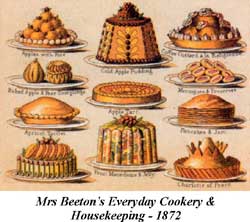
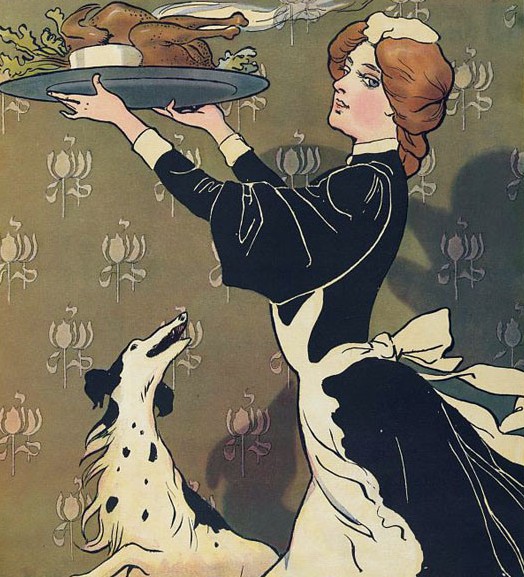
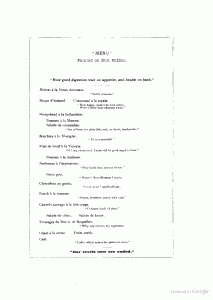
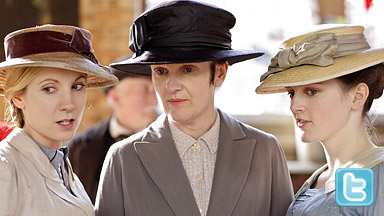
If the dish was made of a good quality silver, it would have looked gorgeous on a dark dining room table as an expensive decorative piece. Just like I leave my silver fruit bowl on the dining room table, these days. But no scratches or burns, thanks!
Most certainly! A few of the cookbooks had pictures of how to display the chafing dish on a table.
They are easy to find for under $20 at thrift stores. i had been holding out for a nice silver plate one until I found the one i bought. It’s copper with brass trim, a small ebony handle on each side and knob on the cover. It has it’s original burner. Even though it wasn’t silver, it was too elegant to resist! I found others like it on Ebay. apparently, it dates from right at the turn of the century and sells for around $100. I only paid $15 but I’ve fallen in love with it and wouldn’t sell it. Thanks for this article! I haven’t tried to cook with it, yet. I didn’t know there were actually specialty cookbooks. Now I have to add a few of those to the cookbook collection.
Good to know! I’ve been tempted to buy one.
If you do use yours, please come back and tell us of your chafing dish adventures, lol!